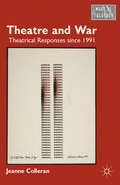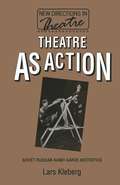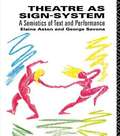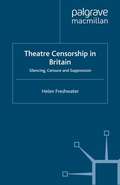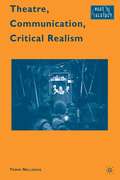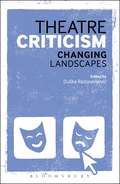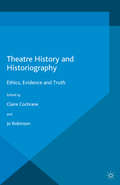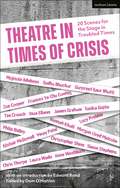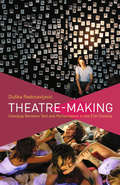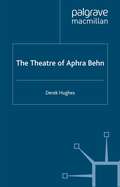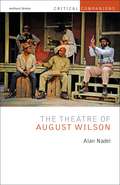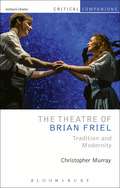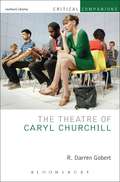- Table View
- List View
Theatre and War: Theatrical Responses since 1991 (What is Theatre?)
by J. ColleranHow has the media since the First Gulf War altered political analysis and how has this alteration has in turn affected socially-critical art? Colleran examines more than forty plays, many written in direct response to the 1991 war in Iraq as well as to the 9/11 attacks and the retaliatory actions in Iraq and Afghanistan.
Theatre as Action: Soviet Russian Avant-Garde Aesthetics (New Directions in Theatre)
by Lars Kleberg trans Charles RougleRussian and Soviet avant-garde theatre attempted to create a new art for post-revolutionary, post-1917 Russian and Soviet society. But what were the assumptions made of the audience and by the audience and was there a gap between the two? This original book studies the confrontation of the ideal with the reality of the Soviet 1920s, revealing the Wagnerian and Symbolist utopia beneath, and its crisis.
Theatre as Sign-System: A Semiotics of Text and Performance (PDF)
by Elaine Aston George SavonaThis invaluable student handbook is the first detailed guide to explain in detail the relationship between the drama text and the theory and practice of drama in performance. Beginning at the beginning, with accessible explanations of the meanings and methods of semiotics, Theatre as Sign Systemaddresses key drama texts and offers new and detailed information about the theories of performance.
Theatre Blogging: The Emergence of a Critical Culture
by Megan VaughanIn this epic history-cum-anthology, Megan Vaughan tells the story of the theatre blogosphere from the dawn of the carefully crafted longform post to today's digital newsletters and social media threads. Contextualising the key debates of fifteen years of theatre history, and featuring the writings of over 40 theatre bloggers, Theatre Blogging brings past and present practitioners into conversation with one another.Starting with Encore Theatre Magazine and Chris Goode in London, George Hunka and Laura Axelrod in New York, Jill Dolan at Princeton University, and Alison Croggon in Melbourne, the work of these influential early adopters is considered alongside those who followed them.Vaughan explores issues that have affected both arts journalism and the theatre industry, profiling the activist bloggers arguing for broader representation and better working conditions, highlighting the innovative dramaturgical practices that have been developed and piloted by bloggers, and offering powerful insights into the precarious systems of labour and economics in which these writers exist. She concludes by considering current threats to the theatre blogosphere, and how the form continues to evolve in response to them.
Theatre Blogging: The Emergence of a Critical Culture
by Megan VaughanIn this epic history-cum-anthology, Megan Vaughan tells the story of the theatre blogosphere from the dawn of the carefully crafted longform post to today's digital newsletters and social media threads. Contextualising the key debates of fifteen years of theatre history, and featuring the writings of over 40 theatre bloggers, Theatre Blogging brings past and present practitioners into conversation with one another.Starting with Encore Theatre Magazine and Chris Goode in London, George Hunka and Laura Axelrod in New York, Jill Dolan at Princeton University, and Alison Croggon in Melbourne, the work of these influential early adopters is considered alongside those who followed them.Vaughan explores issues that have affected both arts journalism and the theatre industry, profiling the activist bloggers arguing for broader representation and better working conditions, highlighting the innovative dramaturgical practices that have been developed and piloted by bloggers, and offering powerful insights into the precarious systems of labour and economics in which these writers exist. She concludes by considering current threats to the theatre blogosphere, and how the form continues to evolve in response to them.
Theatre Censorship in Britain: Silencing, Censure and Suppression
by H. FreshwaterThis exploration of the wide variety of censorship that has shaped theatrical performance in twentieth and twenty-first century Britain examines the unpredictable outcomes of censorship, deep-seated anxieties about the performative influence of the stage, and the complex questions raised by acts of theatrical censorship.
Theatre, Communication, Critical Realism (What is Theatre?)
by T. NellhausFrom oral culture, through the advent of literacy, to the introduction of printing, to the development of electronic media, communication structures have radically altered culture in profound ways. As the first book to take a critical realist approach to culture, Theatre, Communication, Critical Realism examines theatre and its history through the interaction of society s structures, agents, and discourses. Tobin Nellhaus shows that communication structure - a culture s use and development of speech, handwriting, printing, and electronics - explains much about why, when, and how theatre has transformed.
Theatre Criticism: Changing Landscapes
by Duška RadosavljevicThe world of theatre criticism is rapidly changing in its form, function and modes of operation in the twenty-first century. The dominance of the internet has led to a growing trend of selfappointed theatre critics and bloggers who are changing the focus and purpose of the discussion around live performance. Even though the blogosphere has garnered suspicion and hostility from some mainstream newspaper critics, it has also provided significant intellectual and ideological challenges to the increasingly conservative profile of the professional critic.This book features 16 commissioned contributions from scholars, arts journalists and bloggers, as well as a small selection of innovative critical practice. Authors from Australia, Canada, Croatia, Germany, Greece, Italy, Latvia, Russia, the UK and the US share their perspectives on relevant historical, theoretical and political contexts influencing the development of the discipline, as well as specific aspects of the contemporary practices and genres of theatre criticism.The book features an introductory essay by its editor, Duška Radosavljevic.
Theatre Criticism: Changing Landscapes
by Duška RadosavljevicThe world of theatre criticism is rapidly changing in its form, function and modes of operation in the twenty-first century. The dominance of the internet has led to a growing trend of selfappointed theatre critics and bloggers who are changing the focus and purpose of the discussion around live performance. Even though the blogosphere has garnered suspicion and hostility from some mainstream newspaper critics, it has also provided significant intellectual and ideological challenges to the increasingly conservative profile of the professional critic.This book features 16 commissioned contributions from scholars, arts journalists and bloggers, as well as a small selection of innovative critical practice. Authors from Australia, Canada, Croatia, Germany, Greece, Italy, Latvia, Russia, the UK and the US share their perspectives on relevant historical, theoretical and political contexts influencing the development of the discipline, as well as specific aspects of the contemporary practices and genres of theatre criticism.The book features an introductory essay by its editor, Duška Radosavljevic.
Theatre-Fiction in Britain from Henry James to Doris Lessing: Writing in the Wings (Routledge Studies in Twentieth-Century Literature)
by Graham WolfeThis volume posits and explores an intermedial genre called theatre-fiction, understood in its broadest sense as referring to novels and stories that engage in concrete and sustained ways with theatre. Though theatre has made star appearances in dozens of literary fictions, including many by modern history’s most influential authors, no full-length study has dedicated itself specifically to theatre-fiction—in fact there has not even been a recognized name for the phenomenon. Focusing on Britain, where most of the world’s theatre-novels have been produced, and commencing in the late-nineteenth century, when theatre increasingly took on major roles in novels, Theatre-Fiction in Britain argues for the benefits of considering these works in relation to each other, to a history of development, and to the theatre of their time. New modes of intermedial analysis are modelled through close studies of Henry James, Somerset Maugham, Virginia Woolf, J. B. Priestley, Ngaio Marsh, Angela Carter, and Doris Lessing, all of whom were deeply involved in the theatre-world as playwrights, directors, reviewers, and theorists. Drawing as much on theatre scholarship as on literary theory, Theatre-Fiction in Britain presents theatre-fiction as one of the past century’s most vital means of exploring, reconsidering, and bringing forth theatre’s potentials.
Theatre-Fiction in Britain from Henry James to Doris Lessing: Writing in the Wings (Routledge Studies in Twentieth-Century Literature)
by Graham WolfeThis volume posits and explores an intermedial genre called theatre-fiction, understood in its broadest sense as referring to novels and stories that engage in concrete and sustained ways with theatre. Though theatre has made star appearances in dozens of literary fictions, including many by modern history’s most influential authors, no full-length study has dedicated itself specifically to theatre-fiction—in fact there has not even been a recognized name for the phenomenon. Focusing on Britain, where most of the world’s theatre-novels have been produced, and commencing in the late-nineteenth century, when theatre increasingly took on major roles in novels, Theatre-Fiction in Britain argues for the benefits of considering these works in relation to each other, to a history of development, and to the theatre of their time. New modes of intermedial analysis are modelled through close studies of Henry James, Somerset Maugham, Virginia Woolf, J. B. Priestley, Ngaio Marsh, Angela Carter, and Doris Lessing, all of whom were deeply involved in the theatre-world as playwrights, directors, reviewers, and theorists. Drawing as much on theatre scholarship as on literary theory, Theatre-Fiction in Britain presents theatre-fiction as one of the past century’s most vital means of exploring, reconsidering, and bringing forth theatre’s potentials.
Theatre for the Young (Modern Dramatists)
by Alan EnglandThis book looks at the range of stage plays for young people written and produced in Great Britain by adult professionals. Believing that a play should be judged in the context of a performance, the author has devoted a large part of the book to an account of particular events and attempted to identify those factors which affect the nature and quality of the artefact. He argues that Young People's Theatre is a cultural phenomenon which is both continuous with and distinct from adult theatre. Despite the sometimes utilitarian preoccupations of both 'entertainers' and 'educators', it boasts respectable artistic achievements of its own.
Theatre History and Historiography: Ethics, Evidence and Truth
by Claire CochraneThis collection of essays explores how historians of theatre apply ethical thinking to the attempt to truthfully represent their subject - whether that be the life of a well-known performer, or the little known history of colonial theatre in India - by exploring the process by which such histories are written, and the challenges they raise.
Theatre in Times of Crisis: 20 Scenes for the Stage in Troubled Times
by Edward Bond Mojisola Adebayo Sudha Bhuchar Gurpreet Kaur Bhatti Zoe Cooper Frances Ya-Chu Cowhig Tim Crouch Inua Ellams James Graham Tanika Gupta Hannah Khalil Morgan Lloyd Malcolm Alistair McDowall Vinay Patel Lucy Prebble Philip Ridley Christopher Shinn Simon Stephens Chris Thorpe Laura Wade Anne WashburnTheatre has a complex history of responding to crises, long before they happen. Through stage plays, contemporary challenges can be presented, explored and even foreshadowed in ways that help audiences understand the world around them. Since the theatre of the Greeks, audiences have turned to live theatre in order to find answers in uncertain political, social and economic times, and through this unique collection questions about This anthology brings together a collection of 20 scenes from 20 playwrights that each respond to the world in crisis. Twenty of the world's most prolific playwrights were asked to select one scene from across their published work that speaks to the current world situation in 2020. As COVID-19 continues to challenge every aspect of global life, contemporary theatre has long predicted a world on the edge. Through these 20 scenes from plays spanning from 1980 to 2020, we see how theatre and art has the capacity to respond, comment on and grapple with global challenges that in turn speak to the current time in which we are living. Each scene, chosen by the writer, is prefaced by an interview in which they discuss their process, their reason for selection and how their work reflects both the past and the present. From the political plays of Lucy Prebble and James Graham to the polemics of Philip Ridley and Tim Crouch. From bold works by Inua Ellams, Morgan Lloyd Malcom and Tanika Gupta to the social relevance of Hannah Khalil, Zoe Cooper and Simon Stephens this anthology looks at theatre in the present and asks the question: “how can theatre respond to a world in crisis?” The collection is prefaced by an introduction from Edward Bond, one of contemporary theatre's most prolific dramatists.
Theatre in Times of Crisis: 20 Scenes for the Stage in Troubled Times
by Edward Bond Mojisola Adebayo Sudha Bhuchar Gurpreet Kaur Bhatti Zoe Cooper Frances Ya-Chu Cowhig Tim Crouch Inua Ellams James Graham Tanika Gupta Hannah Khalil Morgan Lloyd Malcolm Alistair McDowall Vinay Patel Lucy Prebble Philip Ridley Christopher Shinn Simon Stephens Chris Thorpe Laura Wade Anne WashburnTheatre has a complex history of responding to crises, long before they happen. Through stage plays, contemporary challenges can be presented, explored and even foreshadowed in ways that help audiences understand the world around them. Since the theatre of the Greeks, audiences have turned to live theatre in order to find answers in uncertain political, social and economic times, and through this unique collection questions about This anthology brings together a collection of 20 scenes from 20 playwrights that each respond to the world in crisis. Twenty of the world's most prolific playwrights were asked to select one scene from across their published work that speaks to the current world situation in 2020. As COVID-19 continues to challenge every aspect of global life, contemporary theatre has long predicted a world on the edge. Through these 20 scenes from plays spanning from 1980 to 2020, we see how theatre and art has the capacity to respond, comment on and grapple with global challenges that in turn speak to the current time in which we are living. Each scene, chosen by the writer, is prefaced by an interview in which they discuss their process, their reason for selection and how their work reflects both the past and the present. From the political plays of Lucy Prebble and James Graham to the polemics of Philip Ridley and Tim Crouch. From bold works by Inua Ellams, Morgan Lloyd Malcom and Tanika Gupta to the social relevance of Hannah Khalil, Zoe Cooper and Simon Stephens this anthology looks at theatre in the present and asks the question: “how can theatre respond to a world in crisis?” The collection is prefaced by an introduction from Edward Bond, one of contemporary theatre's most prolific dramatists.
Theatre, Magic and Philosophy: William Shakespeare, John Dee and the Italian Legacy (Anglo-Italian Renaissance Studies)
by Gabriela Dragnea HorvathAnalyzing Shakespeare's views on theatre and magic and John Dee's concerns with philosophy and magic in the light of the Italian version of philosophia perennis (mainly Marsilio Ficino, Pico della Mirandola and Giordano Bruno), this book offers a new perspective on the Italian-English cultural dialogue at the Renaissance and its contribution to intellectual history. In an interdisciplinary and intercultural approach, it investigates the structural commonalities of theatre and magic as contiguous to the foundational concepts of perennial philosophy, and explores the idea that the Italian thinkers informed not only natural philosophy and experimentation in England, but also Shakespeare's theatre. The first full length project to consider Shakespeare and John Dee in juxtaposition, this study brings textual and contextual evidence that Gonzalo, an honest old Counsellor in The Tempest, is a plausible theatrical representation of John Dee. At the same time, it places John Dee in the tradition of the philosophia perennis-accounting for what appears to the modern scholar the conflicting nature of his faith and his scientific mind, his powerful fantasy and his need for order and rigor-and clarifies Edward Kelly's role and creative participation in the scrying sessions, regarding him as co-author of the dramatic episodes reported in Dee's spiritual diaries. Finally, it connects the Enochian/Angelic language to the myth of the Adamic language at the core of Italian philosophy and brings evidence that the Enochian is an artificial language originated by applying creatively the analytical instruments of text hermeneutics used in the Cabala.
Theatre, Magic and Philosophy: William Shakespeare, John Dee and the Italian Legacy (Anglo-Italian Renaissance Studies)
by Gabriela Dragnea HorvathAnalyzing Shakespeare's views on theatre and magic and John Dee's concerns with philosophy and magic in the light of the Italian version of philosophia perennis (mainly Marsilio Ficino, Pico della Mirandola and Giordano Bruno), this book offers a new perspective on the Italian-English cultural dialogue at the Renaissance and its contribution to intellectual history. In an interdisciplinary and intercultural approach, it investigates the structural commonalities of theatre and magic as contiguous to the foundational concepts of perennial philosophy, and explores the idea that the Italian thinkers informed not only natural philosophy and experimentation in England, but also Shakespeare's theatre. The first full length project to consider Shakespeare and John Dee in juxtaposition, this study brings textual and contextual evidence that Gonzalo, an honest old Counsellor in The Tempest, is a plausible theatrical representation of John Dee. At the same time, it places John Dee in the tradition of the philosophia perennis-accounting for what appears to the modern scholar the conflicting nature of his faith and his scientific mind, his powerful fantasy and his need for order and rigor-and clarifies Edward Kelly's role and creative participation in the scrying sessions, regarding him as co-author of the dramatic episodes reported in Dee's spiritual diaries. Finally, it connects the Enochian/Angelic language to the myth of the Adamic language at the core of Italian philosophy and brings evidence that the Enochian is an artificial language originated by applying creatively the analytical instruments of text hermeneutics used in the Cabala.
Theatre-Making: Interplay Between Text and Performance in the 21st Century
by D. Radosavljevic Duška RadosavljeviTheatre-Making explores modes of authorship in contemporary theatre seeking to transcend the heritage of binaries from the Twentieth century such as text-based vs. devised theatre, East vs. West, theatre vs. performance - with reference to genealogies though which these categories have been constructed in the English-speaking world.
The Theatre of Aphra Behn
by D. HughesDuring the nineteen years of her play-writing career, Aphra Behn had far more new plays staged than anyone else. This book is the first to examine all her theatrical work. It explains her often dominant place in the complex theatrical culture of Charles II's reign, her divided political sympathies, and her interests as a free-thinking intellectual. It also reveals her as a brilliant theatrical practitioner, who used the seen as richly and significantly as the spoken.
The Theatre of August Wilson (Critical Companions)
by Alan Nadel Kevin J. Wetmore Jr. Patrick LonerganThe first comprehensive study of August Wilson's drama introduces the major themes and motifs that unite Wilson's ten-play cycle about African American life in each decade of the twentieth century. Framed by Wilson's life experiences and informed by his extensive interviews, this book provides fresh, coherent, detailed readings of each play, well-situated in the extant scholarship. It also provides an overview of the cycle as a whole, demonstrating how it comprises a compelling interrogation of American culture and historiography. Keenly aware of the musical paradigms informing Wilson's dramatic technique, Nadel shows how jazz and, particularly, the blues provide the structural mechanisms that allow Wilson to examine alternative notions of time, property, and law. Wilson's improvisational logics become crucial to expressing his notions of black identity and resituating the relationship of literal to figurative in the African American community. The final two chapters include contributions by scholars Harry J. Elam, Jr. and Donald E. Pease
The Theatre of August Wilson (Critical Companions)
by Alan Nadel Kevin J. Wetmore Jr. Patrick LonerganThe first comprehensive study of August Wilson's drama introduces the major themes and motifs that unite Wilson's ten-play cycle about African American life in each decade of the twentieth century. Framed by Wilson's life experiences and informed by his extensive interviews, this book provides fresh, coherent, detailed readings of each play, well-situated in the extant scholarship. It also provides an overview of the cycle as a whole, demonstrating how it comprises a compelling interrogation of American culture and historiography. Keenly aware of the musical paradigms informing Wilson's dramatic technique, Nadel shows how jazz and, particularly, the blues provide the structural mechanisms that allow Wilson to examine alternative notions of time, property, and law. Wilson's improvisational logics become crucial to expressing his notions of black identity and resituating the relationship of literal to figurative in the African American community. The final two chapters include contributions by scholars Harry J. Elam, Jr. and Donald E. Pease
The Theatre of Brian Friel: Tradition and Modernity (Critical Companions)
by Christopher MurrayBrian Friel is Ireland's foremost living playwright, whose work spans fifty years and has won numerous awards, including three Tonys and a Lifetime Achievement Arts Award. Author of twenty-five plays, and whose work is studied at GCSE and A level (UK), and the Leaving Certificate (Ire), besides at undergraduate level, he is regarded as a classic in contemporary drama studies. Christopher Murray offers the definitive guide to Friel's work; both a detailed study of individual plays and an exploration of Friel's dual commitment to tradition and modernity across his oeuvre.Beginning with Friel's 1964 work Philadelphia, Here I Come! it follows a broadly chronological route through the principle plays, including Aristocrats, Faith Healer, Translations, Dancing at Lughnasa, Molly Sweeney and The Home Place. Along the way it considers themes of exile, politics, fathers and sons, belief and ritual, history, memory, gender inequality, and loss, all set against the dialectic of tradition and modernity.
The Theatre of Brian Friel: Tradition and Modernity (Critical Companions)
by Christopher Murray Csilla Bertha David Krause Shaun RichardsBrian Friel is Ireland's foremost living playwright, whose work spans fifty years and has won numerous awards, including three Tonys and a Lifetime Achievement Arts Award. Author of twenty-five plays, and whose work is studied at GCSE and A level (UK), and the Leaving Certificate (Ire), besides at undergraduate level, he is regarded as a classic in contemporary drama studies. Christopher Murray offers the definitive guide to Friel's work; both a detailed study of individual plays and an exploration of Friel's dual commitment to tradition and modernity across his oeuvre.Beginning with Friel's 1964 work Philadelphia, Here I Come! it follows a broadly chronological route through the principle plays, including Aristocrats, Faith Healer, Translations, Dancing at Lughnasa, Molly Sweeney and The Home Place. Along the way it considers themes of exile, politics, fathers and sons, belief and ritual, history, memory, gender inequality, and loss, all set against the dialectic of tradition and modernity.
The Theatre of Caryl Churchill (Critical Companions)
by R. Darren GobertThe Theatre of Caryl Churchill documents and analyses the major plays and productions of one of Britain's greatest and most innovative playwrights. Drawing on hundreds of never-before-seen archival sources from the US and the UK, it provides an essential guide to Churchill's groundbreaking work for students and theatregoers. Each chapter illuminates connections across plays and explores major scripts alongside unpublished and unfinished projects. Each considers the rehearsal room, the stage, and the printed text. Each demonstrates how Churchill has pushed the boundaries of dramatic aesthetics while posing urgent political and theoretical questions. But since each maps Churchill's work in a different way, each deploys a different reading practice - for many approaches are necessary to characterise such a restlessly imaginative and prolific career. Through its five interlocking parts, The Theatre of Caryl Churchill tells a story about the playwright, her work, and its place in contemporary drama.
The Theatre of Caryl Churchill (Critical Companions)
by R. Darren GobertThe Theatre of Caryl Churchill documents and analyses the major plays and productions of one of Britain's greatest and most innovative playwrights. Drawing on hundreds of never-before-seen archival sources from the US and the UK, it provides an essential guide to Churchill's groundbreaking work for students and theatregoers. Each chapter illuminates connections across plays and explores major scripts alongside unpublished and unfinished projects. Each considers the rehearsal room, the stage, and the printed text. Each demonstrates how Churchill has pushed the boundaries of dramatic aesthetics while posing urgent political and theoretical questions. But since each maps Churchill's work in a different way, each deploys a different reading practice - for many approaches are necessary to characterise such a restlessly imaginative and prolific career. Through its five interlocking parts, The Theatre of Caryl Churchill tells a story about the playwright, her work, and its place in contemporary drama.
